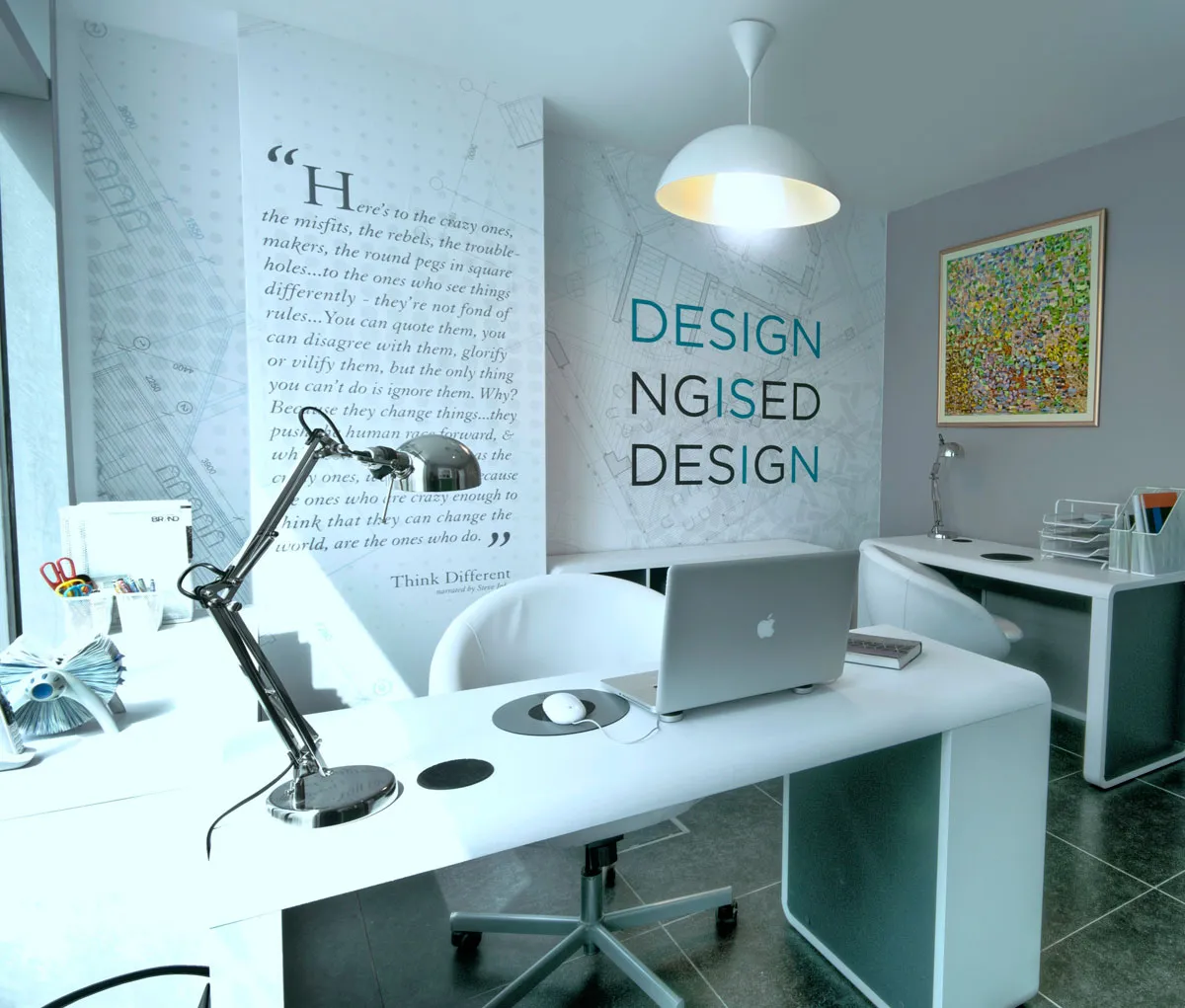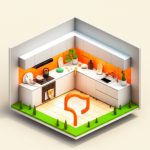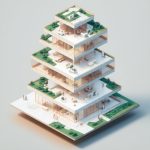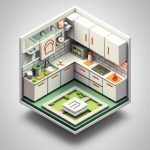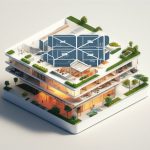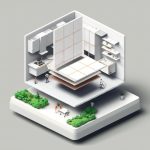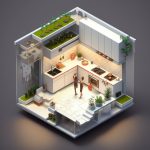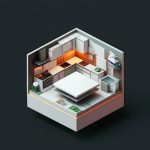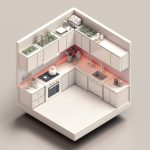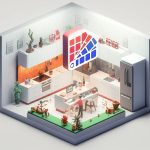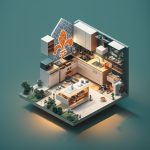Stepping into a beautifully designed room should feel like embarking on an experience. It’s more than just furniture; it’s about the ambiance, the mood, and the feeling you get when you’re surrounded by carefully curated elements. This is where the synergy between graphic design and interior design comes into play. By weaving together visual communication and spatial awareness, we can transform ordinary spaces into extraordinary experiences.
Graphic Design for Interior Designers: Enhancing Spaces Beyond Functionality
Imagine walking into a room where every detail, from the signage to the wall art, tells a story. That’s the power of graphic design in interior design. It’s not just about making things look pretty; it’s about creating a cohesive narrative that resonates with the people who use the space.
Weaving Visuals into the Fabric of a Room
Graphic design acts as the unifying thread that connects all elements of a room. Clear and aesthetically pleasing signage seamlessly guides visitors, while carefully selected typography, color palettes, and visual elements work together to evoke specific moods and emotions. This transforms a simple design concept into a cohesive and visually stunning space.
Think about the impact of a well-designed restaurant menu. The typography, layout, and imagery all work together to entice diners and enhance their experience.
Where Art Meets Architecture
Graphic design and interior design are two sides of the same coin, working harmoniously to build a brand identity for a space. This partnership extends beyond logos to encompass wall art, furniture patterns, and even the smallest details on textiles. Each graphic element contributes to the overall story of the room, imbuing it with character and personality.
For example, a hotel lobby might feature a custom-designed mural that reflects the local culture and history, instantly giving guests a sense of place.
Bringing Spaces to Life with Visual Tales
Graphic design gives a voice to the walls themselves. A stunning wall mural, custom lighting fixtures casting intricate shadows, or thought-provoking artwork transform spaces into extraordinary experiences.
Imagine a children’s hospital waiting room adorned with playful murals and interactive installations. These elements not only brighten the space but also create a welcoming and comforting atmosphere for young patients.
A World of Creative Opportunities
Graphic design and interior design share a common language: visual communication. Professionals in both fields possess a deep understanding of design principles and creativity. By adding graphic design skills to an interior design repertoire, designers unlock a world of possibilities, offering more comprehensive services and adapting to the evolving needs of clients.
For instance, an interior designer with graphic design skills can create custom wallpaper patterns, design unique signage for a retail space, or even develop a cohesive branding strategy for a hotel, encompassing everything from stationery to staff uniforms.
How Does Graphic Design Enhance Interior Design Functionality?
A visually stunning room loses its appeal if people can’t navigate it easily or understand its purpose. Graphic design swoops in to address these functional aspects, ensuring spaces are both beautiful and user-friendly.
Making it Easy to Find Your Way
Clear, easy-to-read signage is essential for wayfinding, especially in large or complex spaces like hospitals, airports, and shopping malls. Graphic design ensures that these signs are not only informative but also blend seamlessly with the surrounding décor.
Imagine trying to find your gate in a crowded airport terminal without clear signage. Graphic design helps us navigate these spaces effectively, reducing stress and confusion.
Creating Experiences That Wow
Graphic design has the power to transform a mundane space into an unforgettable experience. Vibrant murals, custom lighting that sets the mood, and strategically placed artwork can evoke a wide range of emotions and create a lasting impression.
Think about the impact of a well-designed museum exhibit. Graphic elements, such as informative panels, interactive displays, and carefully chosen lighting, enhance the visitor experience and bring the exhibits to life.
Designing for Everyone
Good design is inclusive design. Graphic design plays a crucial role in making spaces accessible to everyone, regardless of their abilities. This might involve using high-contrast color combinations for better readability, incorporating tactile elements for people with visual impairments, and designing signage that meets accessibility standards.
For example, a restaurant menu might include Braille or large print options to accommodate visually impaired patrons, ensuring everyone can access the information.
Where Style Meets Substance
Graphic design elevates the overall aesthetic of a space while simultaneously improving its functionality. Carefully chosen color palettes, eye-catching patterns, and interesting textures add depth and visual interest, creating a cohesive and inviting ambiance.
Think about the difference between a bland office space and one with thoughtfully designed graphics, such as wall murals that inspire creativity or patterns that add a touch of playfulness. These elements can boost morale and productivity.
Teamwork Makes the Dream Work
The true magic unfolds when graphic designers and interior designers collaborate. By combining their expertise and bouncing ideas off each other, they can create spaces that are both visually stunning and highly functional.
Imagine a retail store where the interior design seamlessly incorporates the brand’s visual identity through custom-designed displays, signage, and packaging. This collaborative approach creates a cohesive and memorable brand experience for shoppers.
Graphic design is not merely about aesthetics; it’s a powerful tool that enhances the functionality, accessibility, and overall experience of interior spaces. By embracing the principles of good design, we can create spaces that are both beautiful and welcoming, easy to navigate, and a joy to be in.
What is the Impact of Graphic Design on Interior Aesthetics?
Graphic design infuses interior spaces with visual interest and personality. It’s the art of using logos, typography, and patterns to create a cohesive and aesthetically pleasing environment.
Color Theory and Visual Harmony
Graphic designers possess a deep understanding of color theory, which allows them to create balanced and harmonious color palettes that complement the overall design scheme.
For example, a designer might use a cool color palette with shades of blue and green to create a calming atmosphere in a spa, while a warm palette with reds and oranges might be used to create an energetic vibe in a gym.
Typography and Visual Hierarchy
Typography plays a crucial role in creating visual hierarchy and guiding the eye through a space. Graphic designers carefully select typefaces that complement the design aesthetic and ensure readability.
Imagine a hotel lobby with a bold and elegant typeface used for the hotel’s name and wayfinding signage, creating a sense of sophistication and luxury.
Patterns and Textures
Patterns and textures add depth and visual interest to interior spaces. Graphic designers can create custom patterns for wallpaper, textiles, or even flooring, adding a unique touch to the design.
For instance, a designer might incorporate a geometric pattern into the wallpaper of a modern living room to add a touch of visual interest, or use a floral pattern in a bedroom to create a more romantic and feminine feel.
Enhancing Functionality Through Visual Cues
Interior designers often borrow concepts from graphic design to enhance the functionality of a space. They might use visual cues, such as lines or arrows, to direct the flow of traffic, or create focal points with strategically placed artwork or lighting.
Think about how a well-placed mirror can make a small room feel larger, or how a brightly colored accent wall can draw attention to a specific area.
Collaboration for Cohesive Design
When graphic designers and interior designers collaborate, they bring their unique perspectives and expertise to the table, resulting in innovative and cohesive design solutions.
For example, a restaurant design team might work together to create a cohesive brand identity that is reflected in everything from the menu design and signage to the interior décor and staff uniforms.
By understanding the principles of graphic design, interior designers can elevate their designs, creating spaces that are both beautiful and functional.
How Graphic Design Shapes Emotional Experiences in Interior Spaces?
We’ve all walked into a room and instantly felt a certain way. Maybe it was a sense of calm and serenity in a spa, or a burst of energy and excitement in a nightclub. Graphic design plays a subtle yet powerful role in shaping these emotional experiences.
The Psychology of Color
Colors have a profound impact on our emotions and behaviors. Warm colors, such as red, orange, and yellow, tend to evoke feelings of warmth, energy, and excitement. Cool colors, such as blue, green, and purple, are often associated with calmness, peace, and tranquility.
- Red: Increases heart rate, stimulates appetite. Think restaurants and gyms.
- Blue: Promotes relaxation and tranquility. Ideal for bedrooms and bathrooms.
- Green: Evokes feelings of nature, peace, and renewal. Often used in hospitals and spas.
- Yellow: Stimulates creativity and mental activity. A good choice for offices and classrooms.
Interior designers use color psychology to create specific moods and atmospheres. For example, a fast-food restaurant might use bright reds and yellows to stimulate appetite and encourage quick turnover, while a high-end restaurant might opt for calming blues and greens to create a more relaxed and sophisticated ambiance.
The Power of Shapes
Shapes also hold psychological power, influencing our perceptions and emotions on a subconscious level.
| Shape | Emotional Impact | Example |
|---|---|---|
| Circle | Unity, harmony, completeness | Circular rugs, round tables |
| Square | Stability, order, security | Square coffee tables, grid-patterned wallpaper |
| Triangle | Strength, energy, direction | Triangular patterns, A-frame ceilings |
| Vertical Lines | Height, grandeur, formality | Tall windows, vertical stripes |
| Horizontal Lines | Calmness, stability, relaxation | Long sofas, low ceilings |
By understanding the emotional impact of shapes, designers can use them strategically to create desired effects. For example, a designer might use rounded shapes and soft curves in a spa to promote relaxation, while a corporate office might incorporate more angular shapes to convey strength and stability.
Creating a Sensory Experience
Graphic design elements can also be used to create a multi-sensory experience.
- Lighting: Different types of lighting can create different moods. Soft, diffused lighting is often used to create a relaxing atmosphere, while bright, focused lighting can be used to highlight specific areas or objects.
- Sound: Music and sound effects can be used to create a specific atmosphere or enhance the emotional impact of a space. For example, a retail store might play upbeat music to encourage shoppers to browse longer, while a spa might play calming nature sounds to promote relaxation.
- Texture: Different textures can evoke different emotions. Soft, plush textures are often associated with comfort and luxury, while rough, natural textures can create a more rustic or industrial feel.
By carefully considering all of these elements, designers can create spaces that engage all the senses and create a truly immersive experience.
Graphic design is a powerful tool that can be used to shape the emotional experiences of people in interior spaces. By understanding the psychology of color and shape, and by carefully considering all of the sensory elements of a space, designers can create environments that evoke specific feelings and enhance the overall user experience.
Internal Link Integration:
Throughout your article, consider naturally weaving in your internal links. Here are some potential places where they could fit:
- After mentioning design styles: “If you’re looking for inspiration, check out our German interior design page for some stunning examples.”
- When discussing color palettes: “Learn more about how to choose the right color scheme for your space in our glossary article.”
- When highlighting historical design periods: “For a touch of timeless elegance, explore our Gilded Age interior design page.”
- When showcasing luxurious design concepts: “If you’re drawn to glamorous aesthetics, our glamorous luxury beauty salon interior design page will spark your imagination.”
Remember: The key is to place links organically within the content where they add value to the reader and encourage them to explore related topics.
- Best Color Backsplash For White Cabinets: Ideas Youll Love - November 27, 2025
- White On White Backsplash: A Timeless Kitchen Design Choice - November 26, 2025
- Tile Backsplash With White Cabinets: A Kitchen Design Guide - November 25, 2025
